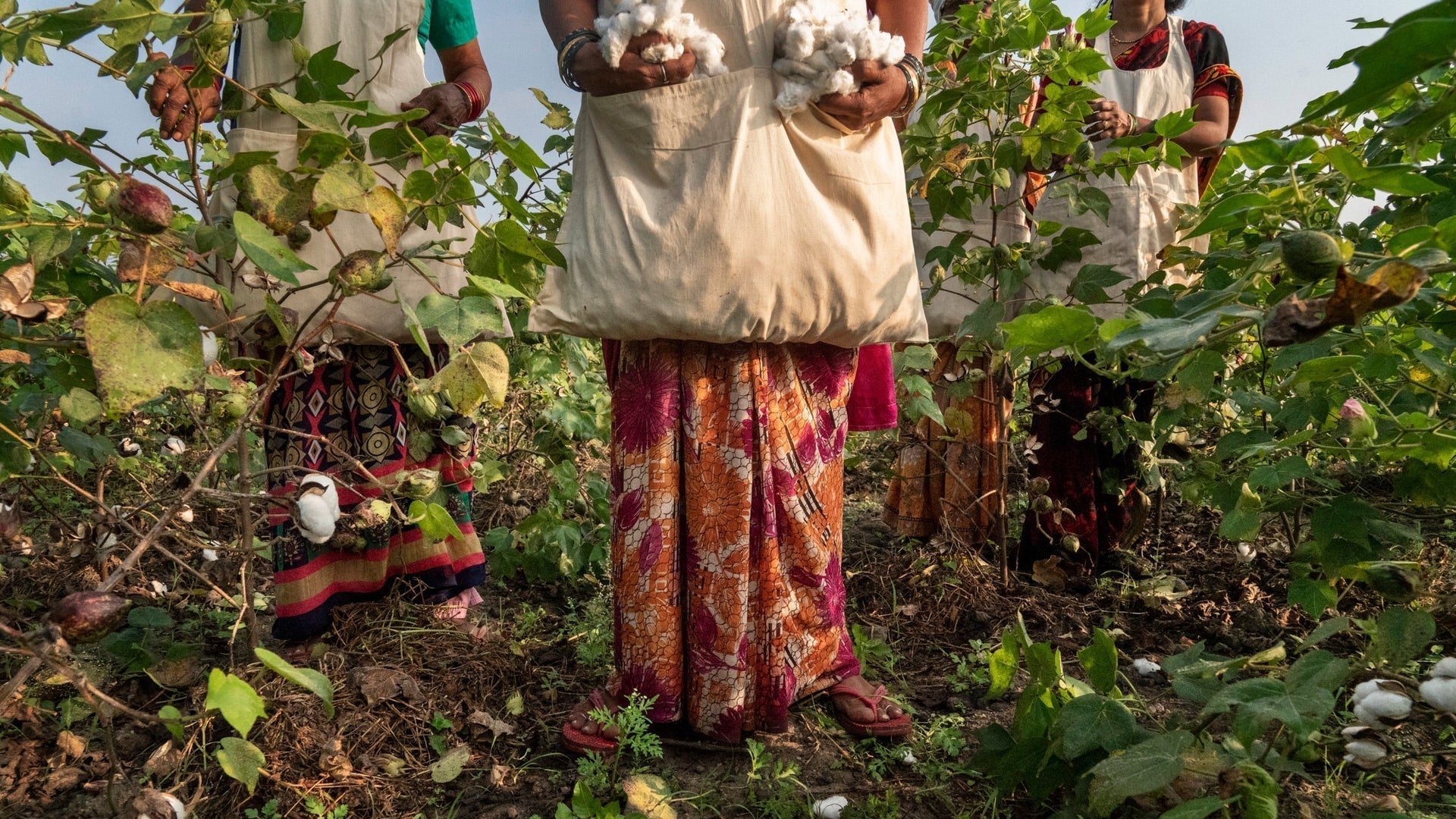This is a test. It’s late in the growing season, and the first puffs of white appear speckled on the landscape. On this farm, plants grow between what would normally be orderly monocropped rows, and workers in beautiful, brightly coloured saris inspect each plant by hand. India is the world’s largest producer of cotton, including organic cotton. But this farm isn’t like the others, and that’s because it’s part of a test: a test to grow our clothes differently.
Growing food and fibre with industrial techniques and harmful chemicals has devastated our climate in just over a century. We believe there’s a better way – Regenerative Organic (RO) farming practices that have the potential to help stop climate change. In an experiment that was the first of its kind, we partnered with over 150 farms in India to grow our first crop of Regenerative Organic Certification Pilot Cotton.
Because healthy soil traps carbon, this type of farming has the potential to draw down more greenhouse gases than other farming methods. If we switch to Regenerative Organic practices, we could turn our agricultural system from problem to solution. As the highest organic standard, Regenerative Organic supports people and animals working together to restore the health of our land to create a future as bright as these colourful, buzzing farms.

A group of women inspects cotton plants at one of over 150 farms in India growing the crop as part of our Regenerative Organic Certification Pilot. Through this certification, farmers receive premiums for the cotton the produce. Photo: Avani Rai.
 Minglasing Deva Singad tends to cotton plants and turmeric and chilli intercrops, which are sold as additional cash crops. Satrudi, India. Photo: Hashim Badani.
Minglasing Deva Singad tends to cotton plants and turmeric and chilli intercrops, which are sold as additional cash crops. Satrudi, India. Photo: Hashim Badani.
 Every few weeks the soil in these fields in India is enriched with the addition of dry compost. The quality of the soil impacts crop yield, water retention, and how much carbon can be stored in the ground. Photo: Hashim Badani.
Every few weeks the soil in these fields in India is enriched with the addition of dry compost. The quality of the soil impacts crop yield, water retention, and how much carbon can be stored in the ground. Photo: Hashim Badani.
 Hansing Datta sorts through the freshly plucked groundnuts from a field in India. These fields are intercropped with corn, tomatoes, chillis, and groundnuts during the months of October and November. Photo: Hashim Badani.
Hansing Datta sorts through the freshly plucked groundnuts from a field in India. These fields are intercropped with corn, tomatoes, chillis, and groundnuts during the months of October and November. Photo: Hashim Badani.
 A natural pesticide made from crushing the leaves of five different plants and leaving them to sit in a clay pot for a week. It is then boiled, reduced by half, mixed with water, and then sprayed over the fields. Photo: Hashim Badani.
A natural pesticide made from crushing the leaves of five different plants and leaving them to sit in a clay pot for a week. It is then boiled, reduced by half, mixed with water, and then sprayed over the fields. Photo: Hashim Badani.
 When it is ready for harvest, cotton is handpicked from its protective case, called a boll. Photo: Avani Rai.
When it is ready for harvest, cotton is handpicked from its protective case, called a boll. Photo: Avani Rai.
 Amrathlal Chogalal Patidar plucks a few marigolds from the field, which are grown alongside the cotton. Marigolds help attract pests, and because they are an important flower for festivals and celebrations, can be sold by farmers as an additional cash crop. Photo: Hashim Badani.
Amrathlal Chogalal Patidar plucks a few marigolds from the field, which are grown alongside the cotton. Marigolds help attract pests, and because they are an important flower for festivals and celebrations, can be sold by farmers as an additional cash crop. Photo: Hashim Badani.
 Two farmers stand with their cows. These animals provide rich ingredients for a rich compost, one important element in building healthy soil. Photo: Avani Rai.
Two farmers stand with their cows. These animals provide rich ingredients for a rich compost, one important element in building healthy soil. Photo: Avani Rai.


























































Rachel is a writer and editor at Patagonia. Her writing has been published in Popular Science, Men’s Health, Shape and Fitness. She spends most of her free time in the ocean swimming and freediving in the Santa Barbara Channel.